The Dynamical Linkage of Atmospheric Blocking to Drought, Heatwave and Urban Heat Island in Southeastern US: A Multi-Scale Case Study
Abstract
:1. Introduction
2. Data
3. Results
3.1. Linkage of Blocking to Southeastern Drought of 2007
3.2. Linkage of Blocking to Southeastern Heatwave of 2007
3.3. Linkage of Blocking to UHI in Birmingham, AL, USA
4. Discussion
5. Conclusions and Further Work
Acknowledgments
Author Contributions
Conflicts of Interest
References
- Rex, D.F. Blocking action in the middle troposphere and its effect upon regional climate. I. An aerological study of blocking action. Tellus 1950, 2, 196–211. [Google Scholar]
- Austin, J.F. The blocking of middle latitude westerly winds by planetary waves. Q. J. R. Meteorol. Soc. 1980, 106, 327–350. [Google Scholar] [CrossRef]
- Colucci, S.J. Planetary-scale preconditioning for the onset of blocking. J. Atmos. Sci. 2001, 58, 933–942. [Google Scholar] [CrossRef]
- Dole, R.M.; Gordon, N.D. Persistent anomalies of the extratropical Northern Hemisphere wintertime circulation: Geopotential distribution and regional persistence characteristics. Mon. Weather Rev. 1983, 111, 1567–1586. [Google Scholar] [CrossRef]
- Wang, S.Y.; Hipps, L.; Gillies, R.R.; Yoon, J. Probable causes of the abnormal ridge accompanying the 2013-2014 California drought: ENSO precursor and anthropogenic warming footprint. Geophys. Res. Lett. 2014, 41, 3220–3226. [Google Scholar] [CrossRef]
- Teng, H.; Branstator, G. Causes of extreme ridges that induce California droughts. J. Clim. 2017, 30, 1477–1492. [Google Scholar] [CrossRef]
- Seager, R.; Hoerling, M.; Schubert, S.; Wang, H.; Lyon, B.; Kumar, A.; Nakamura, J.; Henderson, N. Causes of the 2011–2014 California drought. J. Clim. 2015, 28, 6998–7024. [Google Scholar]
- Williams, A.P.; Seager, R.; Abatzoglou, J.T.; Cook, B.I.; Smerdon, J.E.; Cook, E.R. Contribution of anthropogenic warming to California drought during 2012–2014. Geophys. Res. Lett. 2015, 42, 6819–6828. [Google Scholar] [CrossRef]
- Chase, T.N.; Wolter, K.; Rasool, I. Was the 2003 European summer heat wave unusual in a global context? Geophys. Res. Lett. 2006, 33. [Google Scholar] [CrossRef]
- Fischer, E.M.; Seneviratne, S.I. Soil moisture-atmosphere interactions during the 2003 European summer heat wave. J. Clim. 2007, 20, 5081–5099. [Google Scholar] [CrossRef]
- Garcia-Herrera, R.; Diaz, J.; Trigo, R.M.; Luterbacher, J.; Fischer, E.M. A review of the European summer heat wave of 2003. Crit. Rev. Environ. Sci. Technol. 2010, 40, 267–306. [Google Scholar] [CrossRef]
- Barriopedro, D.; Garcia-Herrera, R.; Lupo, A.R.; Hernández, E. A climatology of Northern Hemisphere blocking. J. Clim. 2006, 19, 1042–1063. [Google Scholar] [CrossRef]
- Renwick, J.A. ENSO-related variability in the frequency of South Pacific blocking. Mon. Weather Rev. 1998, 126, 3117–3123. [Google Scholar] [CrossRef]
- Sáez de Adana, F.J.; Colucci, S.J. Southern Hemisphere blocking onsets associated with upper-tropospheric divergence anomalies. J. Atmos. Sci. 2005, 62, 1614–1625. [Google Scholar] [CrossRef]
- Dong, L.; Vogelsang, T.J.; Colucci, S.J. Interdecadal trend and ENSO-related internal variability in Southern Hemisphere blocking. J. Clim. 2008, 21, 3068–3077. [Google Scholar] [CrossRef]
- Francis, J.; Vavrus, S.J. Evidence linking arctic amplification to extreme weather in mid-latitudes. Geophys. Res. Lett. 2012, 39. [Google Scholar] [CrossRef]
- Wallace, J.M.; Held, I.M.; Thompson, D.W.J.; Trenberth, K.E.; Walsh, J.E. Global warming and winter weather. Science 2014, 343, 729–730. [Google Scholar] [CrossRef] [PubMed]
- Hassanzadeh, P.; Kuang, Z.; Farrell, B. Responses of midlatitude blocks and wave amplitude to changes in the meridional temperature gradient in an idealized dry GCM. Geophys. Res. Lett. 2014, 41, 5223–5232. [Google Scholar] [CrossRef]
- Phelan, P.E.; Kaloush, K.; Miner, M.; Golden, J.; Phelan, B.; Silva, H., III; Taylor, R.A. Urban heat island: Mechanisms, implications, and possible remedies. Annu. Rev. Environ. Resour. 2015, 40, 285–307. [Google Scholar] [CrossRef]
- Rasul, A.; Balzter, H.; Smith, C.; Remedios, J.; Adamu, B.; Sobrino, J.A.; Srivanit, M.; Wang, Q. A review on remote sensing of urban heat and cool islands. Land 2017, 6, 38. [Google Scholar] [CrossRef]
- Debbage, N.; Shepherd, J.M. The urban heat island effect and city contiguity. Comput. Environ. Urban Syst. 2015, 54, 181–194. [Google Scholar] [CrossRef]
- Kalnay, E.; Kanamitsu, M.; Kistler, R.; Collins, W.; Deaven, D.; Gandin, L.; Iredell, M.; Saha, S.; White, G.; Woollen, J.; et al. The NCEP-NCAR 40-Year Reanalysis Project. Bull. Am. Meteorol. Soc. 1996, 77, 437–471. [Google Scholar] [CrossRef]
- Tran, H.; Uchihama, D.; Ochi, S.; Yasuoka, Y. Assessment with satellite data of the urban heat island effects in Asian mega cities. Int. J. Appl. Earth Obs. Geoinf. 2015, 14, 34–48. [Google Scholar]
- Sobrino, J.A.; Jimenez-Munoz, J.C.; Paolini, L. Land surface temperature retrieval from LANDSAT TM 5. Remote Sens. Environ. 2004, 40, 434–440. [Google Scholar] [CrossRef]
- Thorne, K.; Markharn, B.; Barker, P.S.; Biggar, S. Radiometric calibration of Landsat. Photogramm. Eng. Remote Sens. 1997, 63, 853–858. [Google Scholar]
- Palmer, W.C. Meteorological Drought; Department of Commerce: Washington, DC, USA, 1965; 58p.
- Manuel, J. Drought in the Southeast: Lessons for water management. Environ. Health Perspect. 2008, 116, 168–171. [Google Scholar] [CrossRef]
- Tri-State Water Wars among Alabama, Georgia and Florida. Available online: https://www.southernenvironment.org/cases-and-projects/tri-state-water-wars-al-ga-fl (accessed on 1 November 2017).
- Seager, R.; Tzanova, A.; Nakamura, J. Drought in the Southeastern United States: Causes, variability over the Last Millennium, and the potential for future hydroclimate change. J. Clim. 2009, 22, 5021–5045. [Google Scholar] [CrossRef]
- Watson, J.S.; Colucci, S.J. Evaluation of ensemble predictions of blocking in the NCEP global spectral model. Mon. Weather Rev. 2002, 130, 3008–3021. [Google Scholar] [CrossRef]
- Tibaldi, S.; Molteni, F. On the operational predictability of blocking. Tellus 1990, 42, 343–365. [Google Scholar] [CrossRef]
- Horton, R.M.; Mankin, J.S.; Lesk, C.; Coffel, E.; Raymond, C. A review of recent advances in research on extreme heat events. Curr. Clim. Chang. Response 2016, 2, 242–259. [Google Scholar] [CrossRef]
- National Drought Summary from United States Drought Monitor. Available online: http://droughtmonitor.unl.edu/DroughtSummary.aspx (accessed on 1 November 2017).
- Gouveia, C.M.; Bistinas, I.; Liberato, M.L.R.; Bastos, A.; Koutsias, N.; Trigo, R.M. The outstanding synergy between drought, heatwaves and fuel on the 2007 Southern Greece exceptional fire season. Agric. For. Meteorol. 2016, 218, 135–145. [Google Scholar] [CrossRef]
- Amraoui, M.; Liberato, M.L.R.; Calado, T.J.; DaCamara, C.C.; Pinto-Coelho, L.; Trigo, R.M.; Gouveia, C.M. Fire activity over Mediterranean Europe based on information from Meteosat-8. For. Ecol. Manag. 2013, 294, 62–75. [Google Scholar] [CrossRef]
- Hug, W.A. The Study of Urban Heat Islands in the Birmingham and Auburn-Opelika, Alabama Urban Areas, Using Satellite and Observational Techniques. M.S. Thesis, Auburn University, Auburn, AL, USA, 2014; 149p. [Google Scholar]
- Lu, G.Y.; Wong, D.W. An adaptive inverse-distance weighting spatial interpolation techniques. Comput. Geosci. 2008, 34, 1044–1055. [Google Scholar] [CrossRef]
- Zhu, P.; Zhang, Y. Demand for urban forests in United States cities. Landsc. Urban Plan. 2007, 84, 293–300. [Google Scholar] [CrossRef]
- Oke, T.R. The energetic basis of the urban heat island. Q. J. R. Meteorol. Soc. 1982, 108, 1–24. [Google Scholar] [CrossRef]
- Schneidereit, A.; Schubert, S.; Vargin, P.; Lunkkeit, F.; Zhu, X.; Peters, D.H.W.; Fraedrich, K. Large-scale flow and long-lasting blocking high over Russia: Summer 2010. Mon. Weather Rev. 2012, 140, 2967–2981. [Google Scholar] [CrossRef]
- Kingston, D.G.; Stagge, J.H.; Tallaksen, L.M.; Hannah, D.M. European-scale drought: Understanding connections between atmospheric circulation and meteorological drought indices. J. Clim. 2015, 28, 505–516. [Google Scholar] [CrossRef]
- Li, D.; Bou-Zeid, E. Synergistic interactions between urban heat island and heat waves: The impact in cities is larger than the sum of its parts. J. Appl. Meteorol. Climatol. 2013, 52, 2051–2064. [Google Scholar] [CrossRef]
- Li, D.; Sun, T.; Liu, M.; Yang, L.; Wang, L.; Gao, Z. Contrasting responses of urban and rural surface energy budgets to heat waves explain synergies between urban heat islands and heat waves. Environ. Res. Lett. 2015, 10, 054009. [Google Scholar] [CrossRef]
- Founda, D.; Santamouris, M. Synergies between urban heat island and heat waves in Athens (Greece), during an extremely hot summer (2012). Sci. Rep. 2017, 7, 10973. [Google Scholar] [CrossRef] [PubMed]
- Hirsch, A.L.; Pitman, A.J.; Kala, J. The role of land cover change in modulating the soil moisture-temperature land-atmosphere coupling strength over Australia. Geophys. Res. Lett. 2014, 41, 5883–5890. [Google Scholar] [CrossRef]
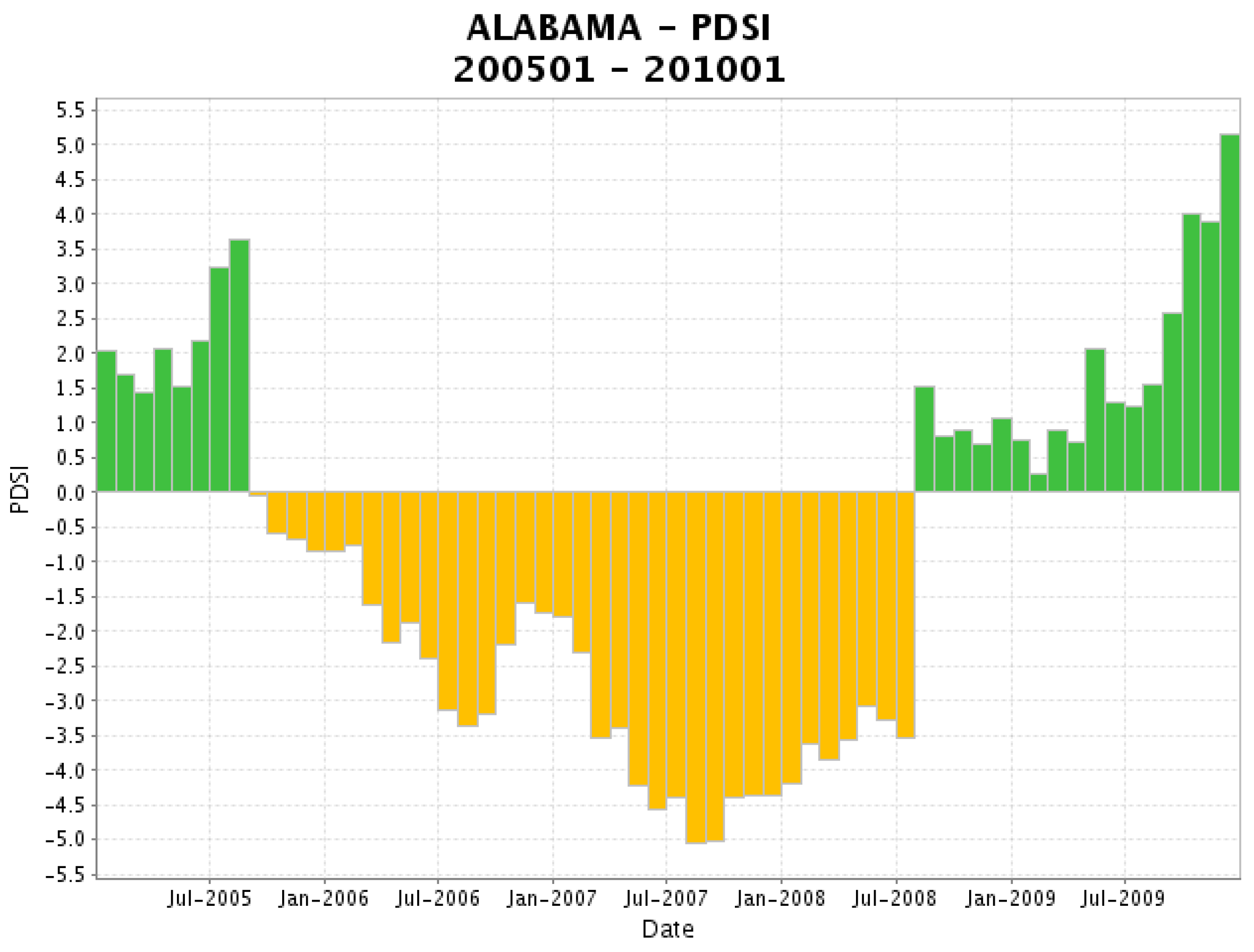

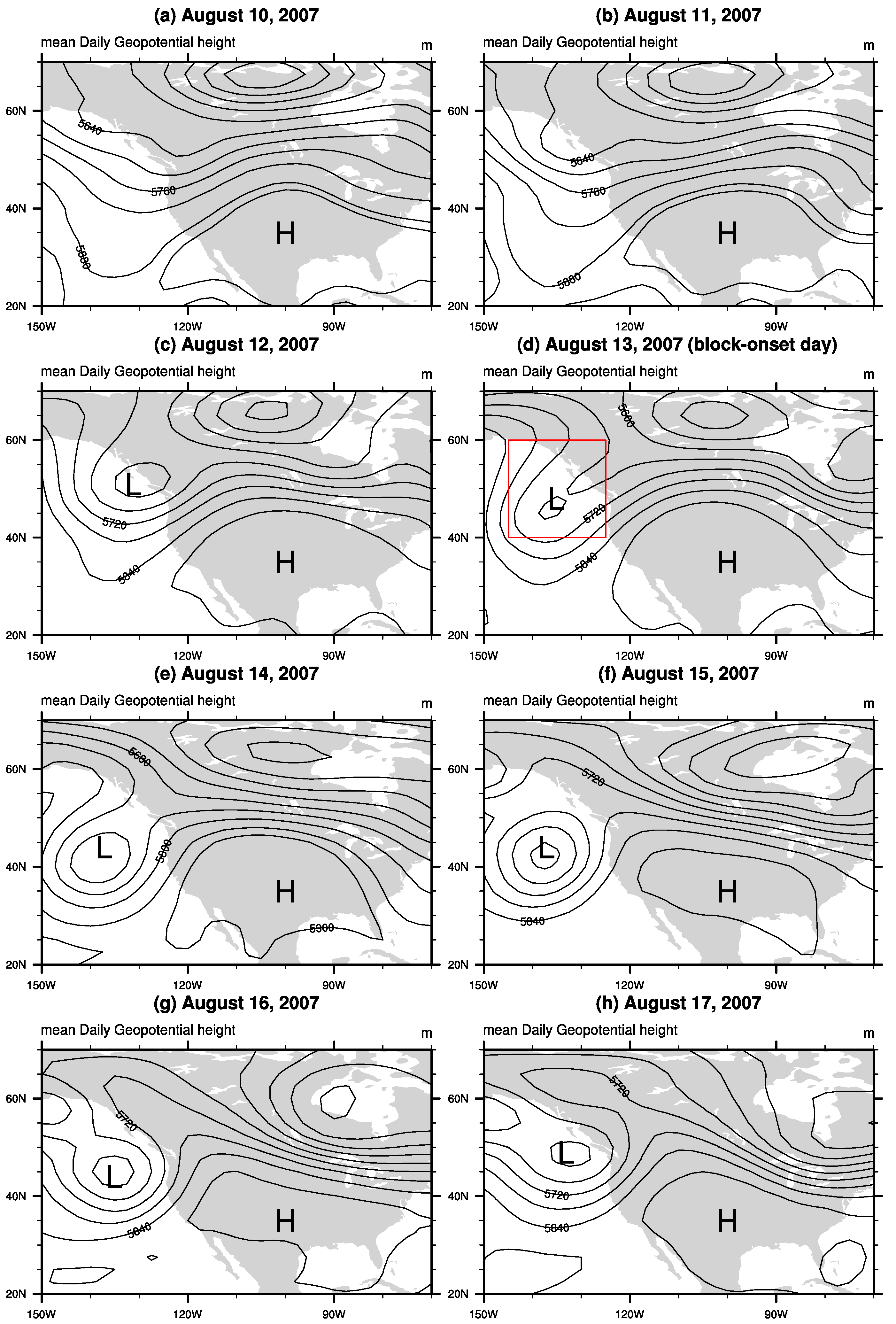
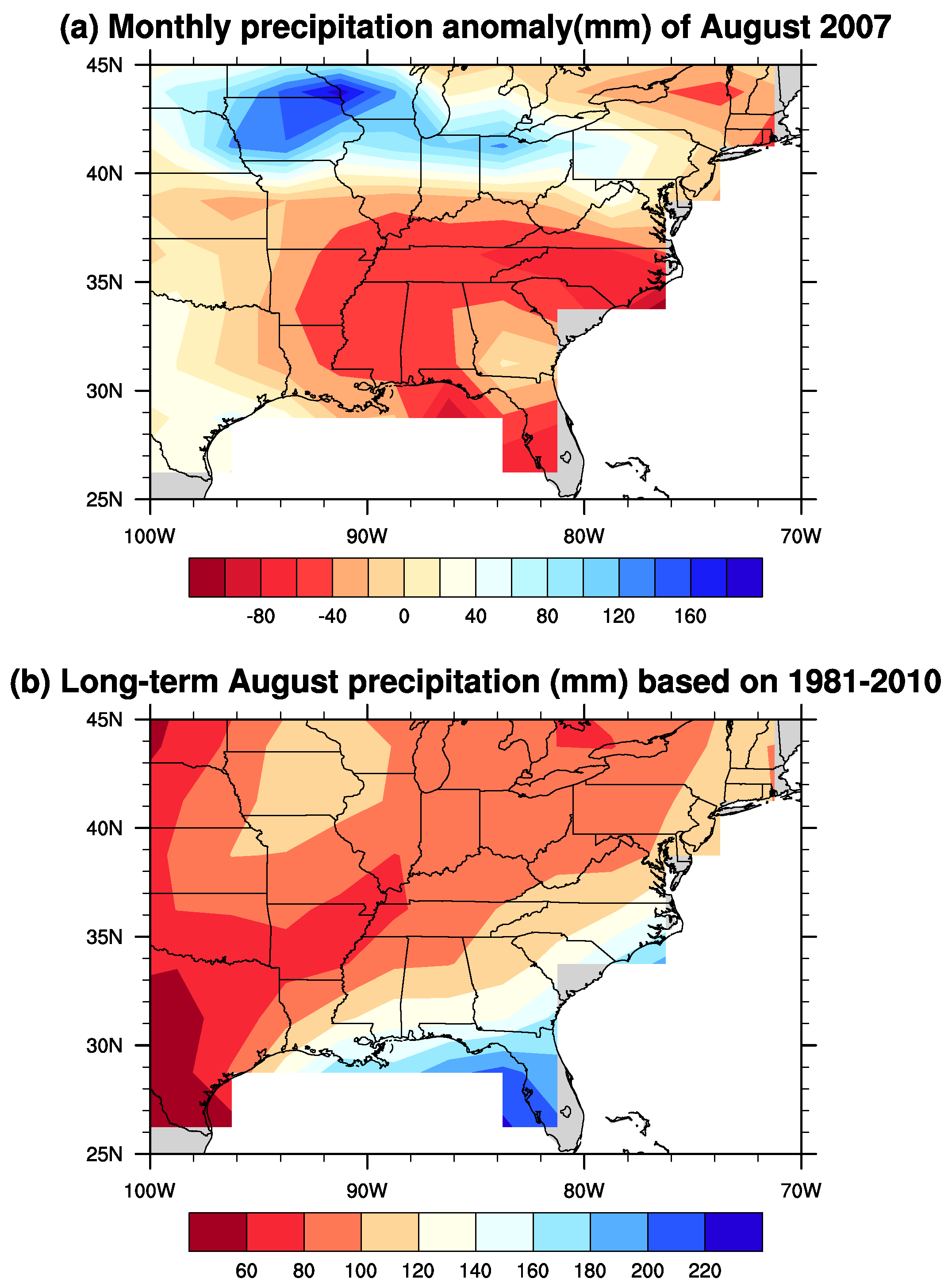
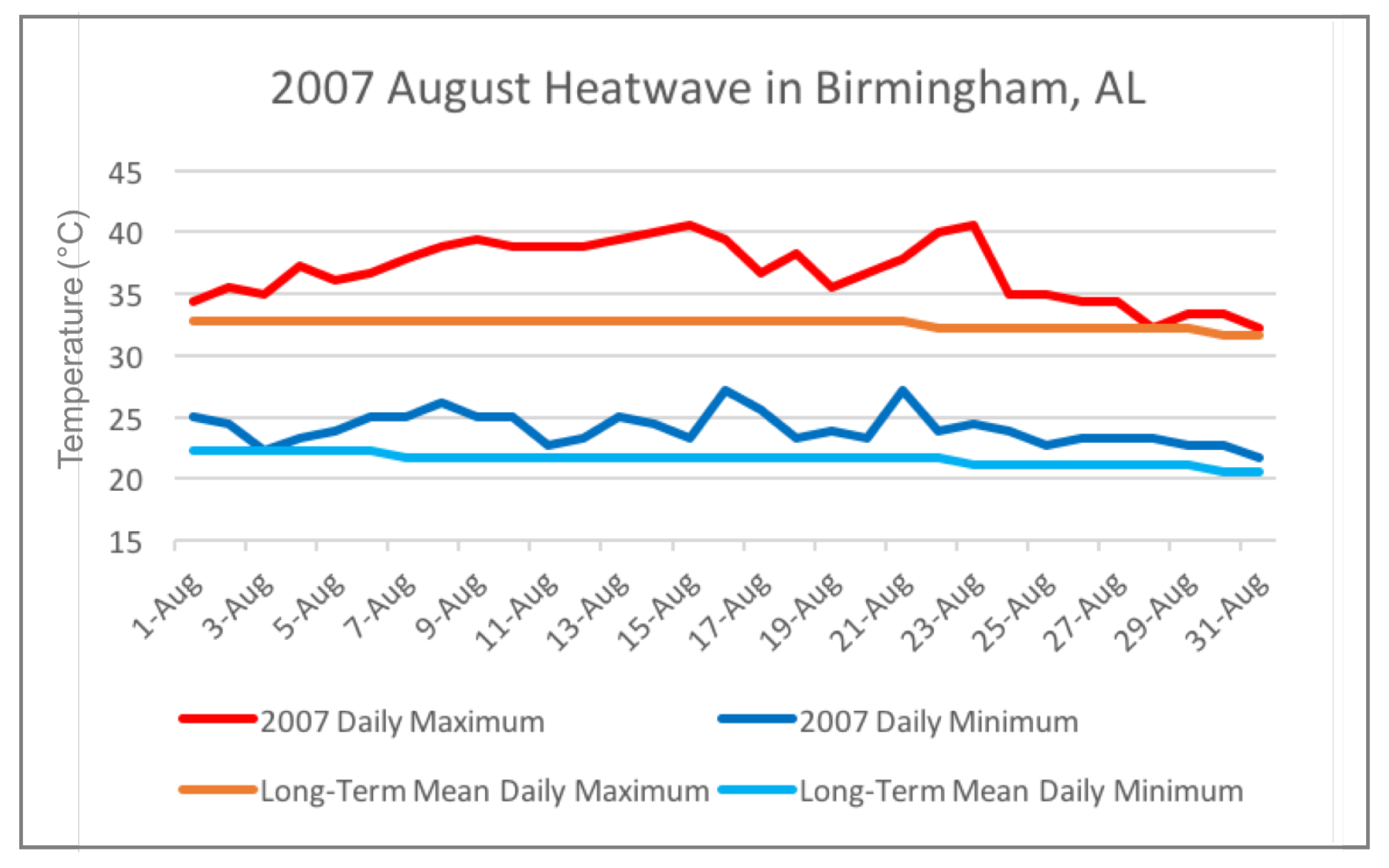
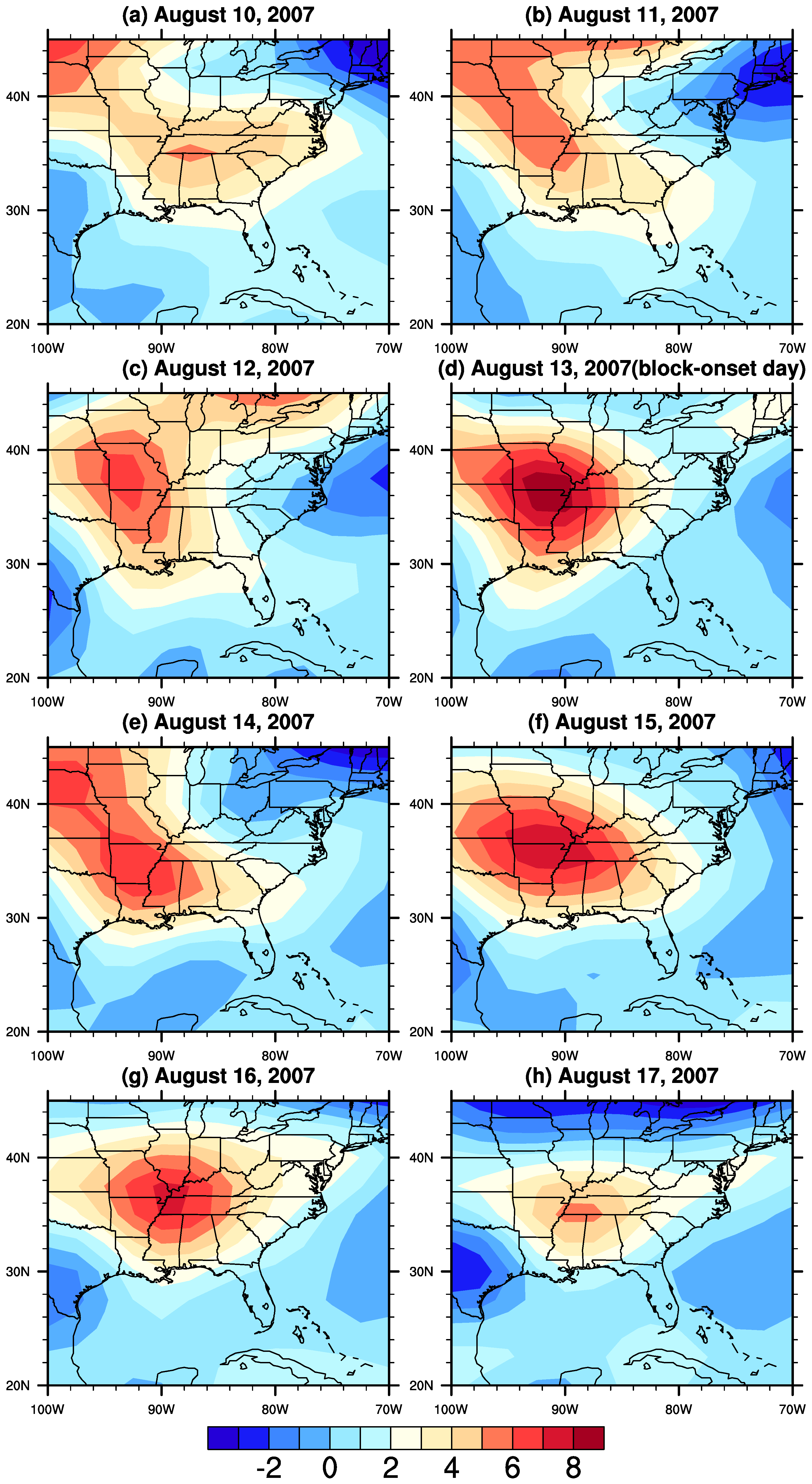
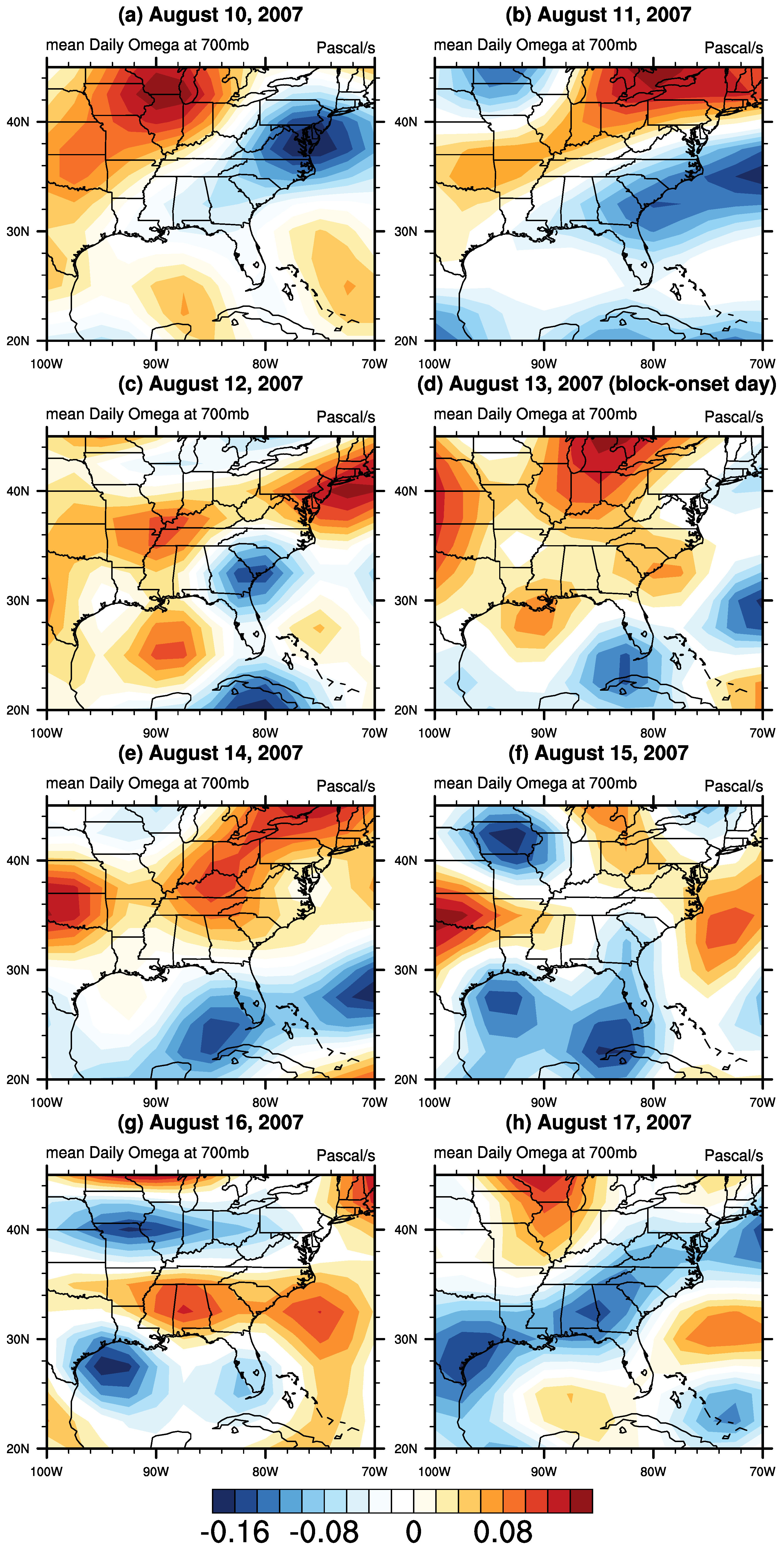
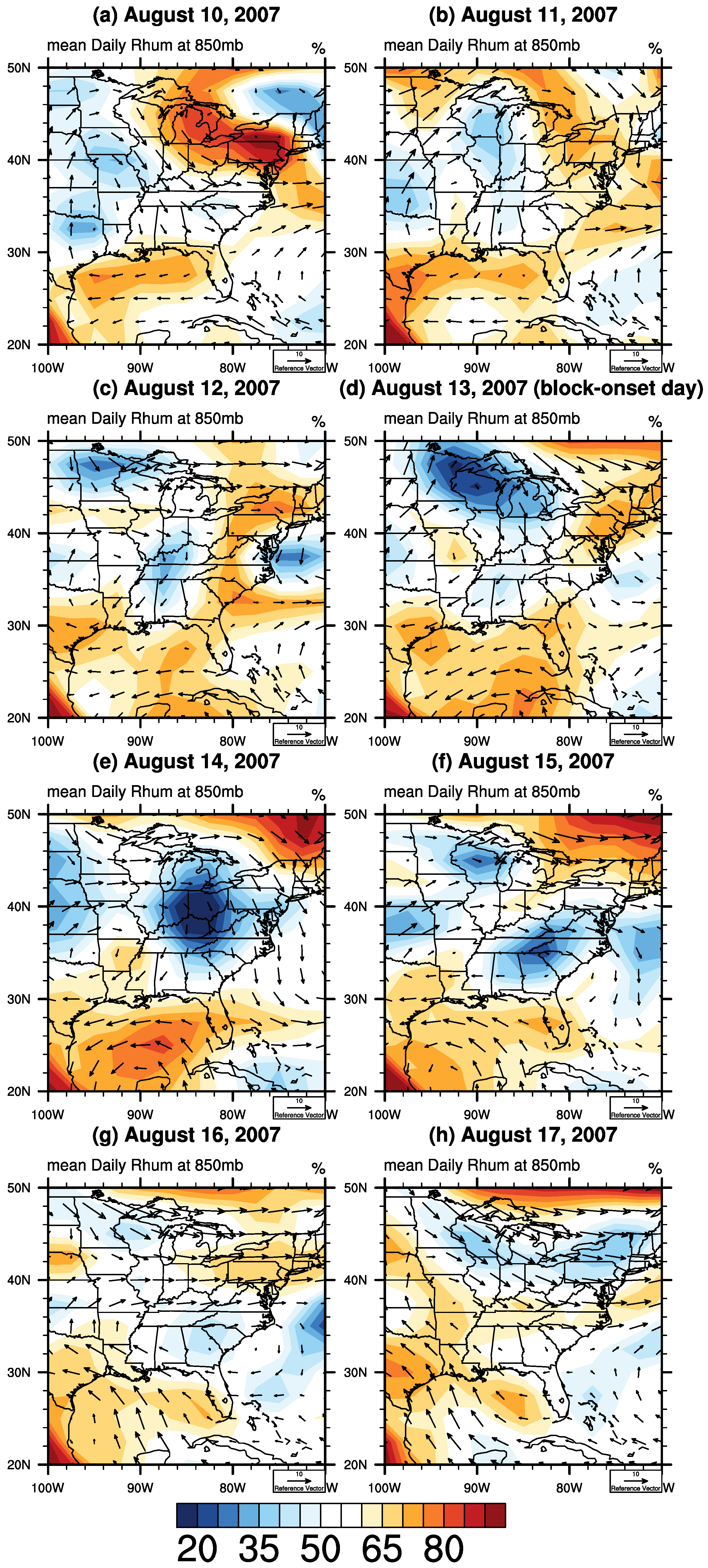
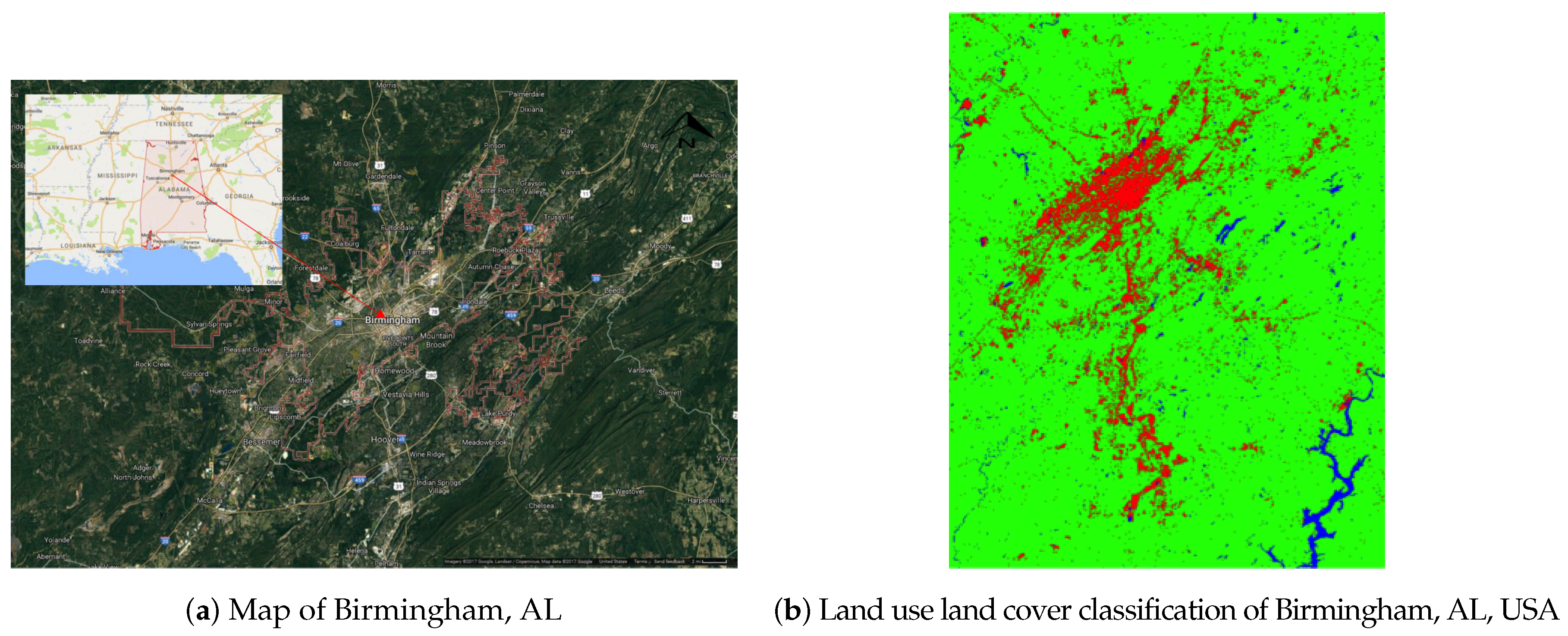

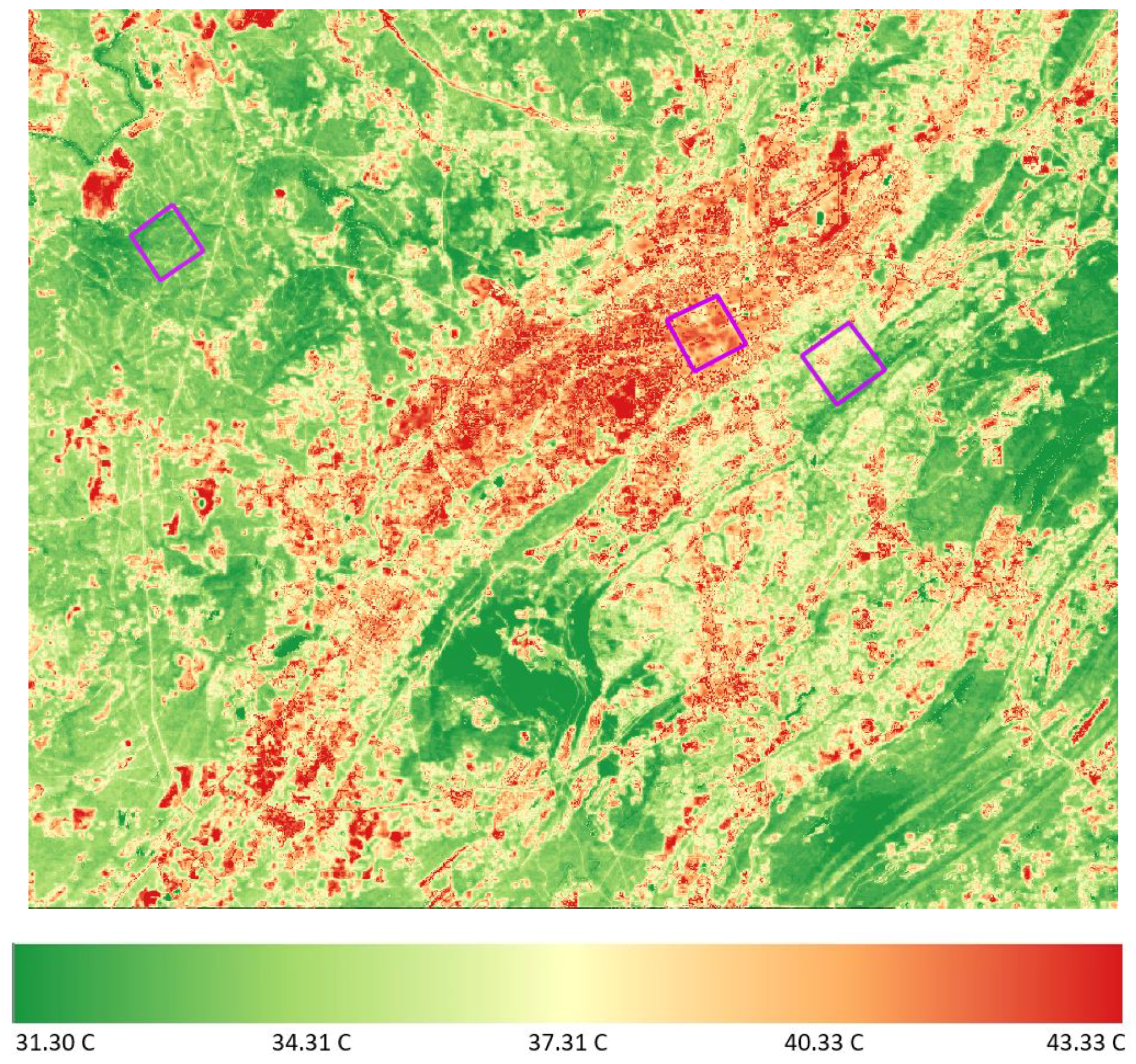
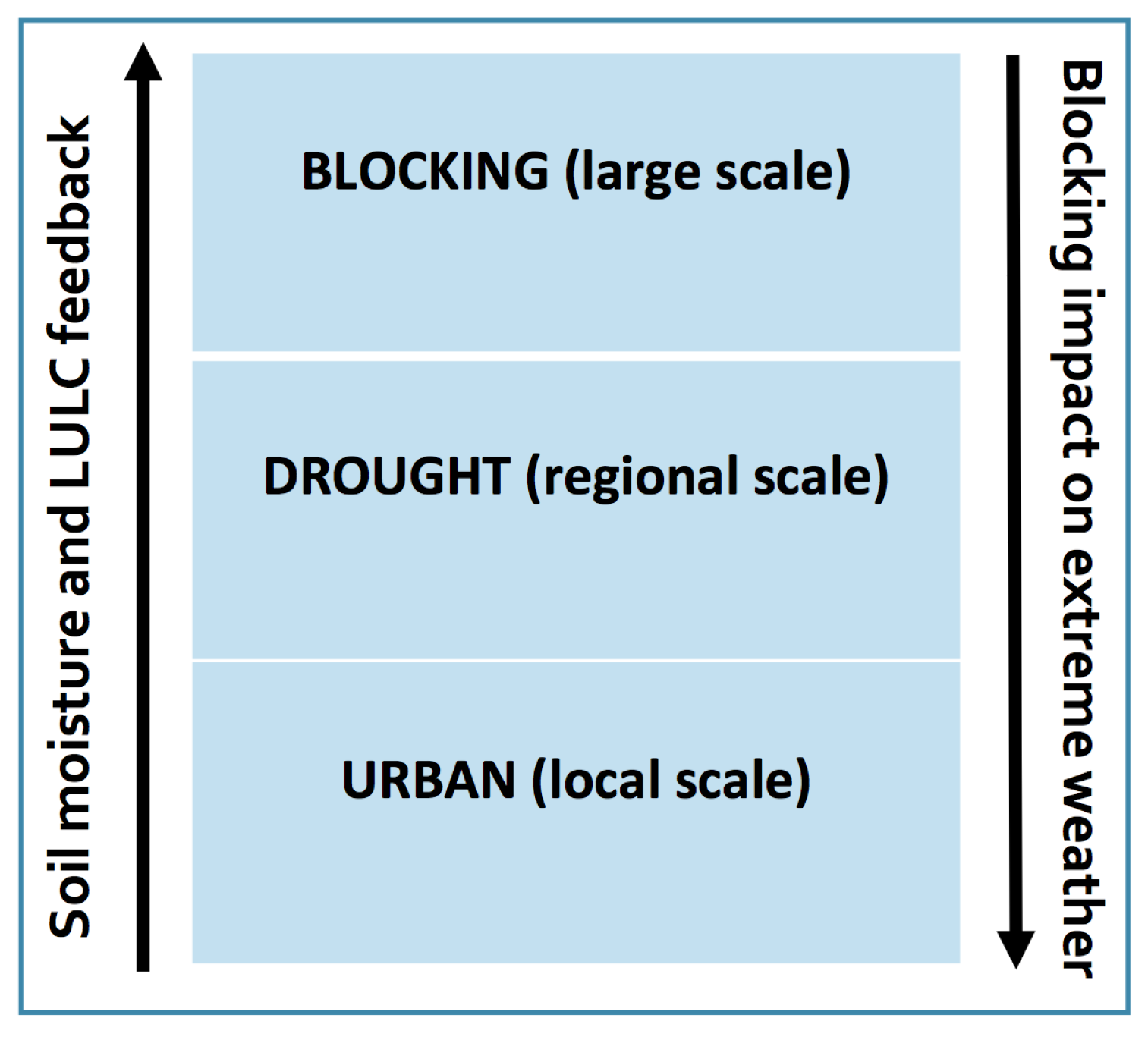
© 2018 by the authors. Licensee MDPI, Basel, Switzerland. This article is an open access article distributed under the terms and conditions of the Creative Commons Attribution (CC BY) license (http://creativecommons.org/licenses/by/4.0/).
Share and Cite
Dong, L.; Mitra, C.; Greer, S.; Burt, E. The Dynamical Linkage of Atmospheric Blocking to Drought, Heatwave and Urban Heat Island in Southeastern US: A Multi-Scale Case Study. Atmosphere 2018, 9, 33. https://doi.org/10.3390/atmos9010033
Dong L, Mitra C, Greer S, Burt E. The Dynamical Linkage of Atmospheric Blocking to Drought, Heatwave and Urban Heat Island in Southeastern US: A Multi-Scale Case Study. Atmosphere. 2018; 9(1):33. https://doi.org/10.3390/atmos9010033
Chicago/Turabian StyleDong, Li, Chandana Mitra, Seth Greer, and Ethan Burt. 2018. "The Dynamical Linkage of Atmospheric Blocking to Drought, Heatwave and Urban Heat Island in Southeastern US: A Multi-Scale Case Study" Atmosphere 9, no. 1: 33. https://doi.org/10.3390/atmos9010033



